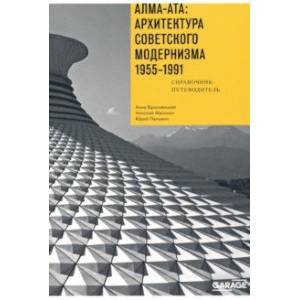Alma-Ata. Architecture of Soviet modernism, 1955-1991. Guide guide
Please sign in so that we can notify you about a reply
"Alma-Ata: Architecture of Soviet modernism 1955-1991"-the second book of the series, begun in 2016 by the reference book of the architecture of Soviet modernism of Moscow. In the book of Architecture historians Anna Bronovitsky and Nikolai Malinin and photographer Yuri Kalmin, more than 60 objects were included - from the circus and the market to the palaces of culture and housing - in a variety of architectural styles created between the Khrushchev reform and the collapse of the USSR. Anna Bronovitskaya and Nikolai Malinin examine each building in a wide context of cultural, social and political history.
In their study, the authors relied both on documents and an interview with Alma-Ata architects, historians, today and former residents of the city. Photography of Yuri Palmin, revealing the aesthetics of buildings or fixing their distortion, is supplemented by rich archival material - drawings, design prospects, historical photographs. The architectural guide can also be considered as a book about the history of the "Golden Age" of the old capital of Kazakhstan, an international and enlightened city with its unique face, attracting talented architects and artists from different ends of the Soviet Union. Today, Alma-Ata can be called the “capital of Soviet modernism”. If the old rivals in terms of architecture-Yerevan and Kyiv, Tashkent and Minsk-lost the heritage of the 1960-1980s, in Alma-Ata it did not suffer such severe loss: in 1997, the capital"s functions were advanced to Astana, which took up the architectural representation of independent Kazakhstan . Alma-Ata remains the current Museum of Soviet Modernism, where you can see the world"s first transparent library and the first postmodern skyscraper in the USSR, and a dam, built by the most powerful directed explosion in history
In their study, the authors relied both on documents and an interview with Alma-Ata architects, historians, today and former residents of the city. Photography of Yuri Palmin, revealing the aesthetics of buildings or fixing their distortion, is supplemented by rich archival material - drawings, design prospects, historical photographs. The architectural guide can also be considered as a book about the history of the "Golden Age" of the old capital of Kazakhstan, an international and enlightened city with its unique face, attracting talented architects and artists from different ends of the Soviet Union. Today, Alma-Ata can be called the “capital of Soviet modernism”. If the old rivals in terms of architecture-Yerevan and Kyiv, Tashkent and Minsk-lost the heritage of the 1960-1980s, in Alma-Ata it did not suffer such severe loss: in 1997, the capital"s functions were advanced to Astana, which took up the architectural representation of independent Kazakhstan . Alma-Ata remains the current Museum of Soviet Modernism, where you can see the world"s first transparent library and the first postmodern skyscraper in the USSR, and a dam, built by the most powerful directed explosion in history
Author:
Author:Bronovitskaya A. Yu .
Cover:
Cover:Cover with valves
Category:
- Category:Arts & Photography
- Category:Engineering & Transportation
- Category:Reference books
ISBN:
ISBN: 9785990971653
No reviews found
